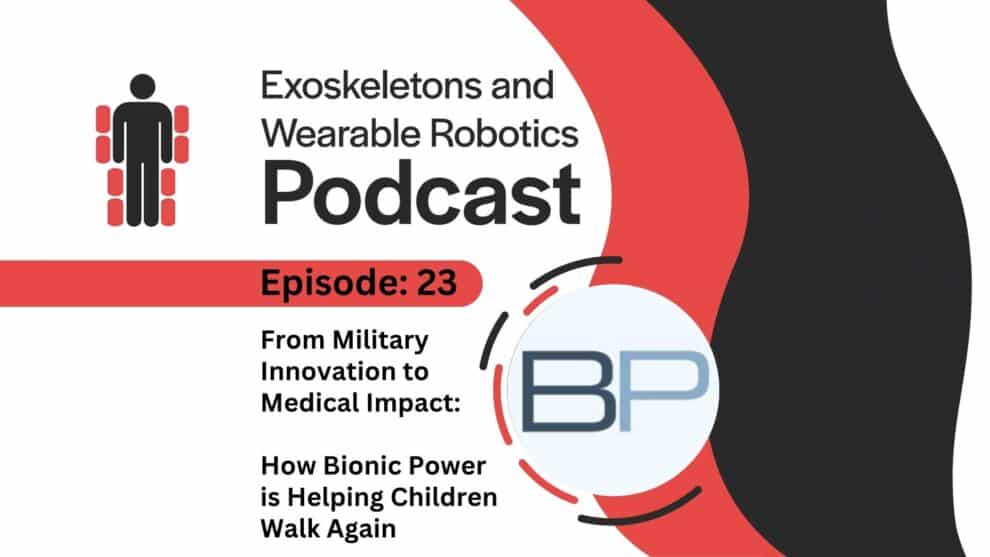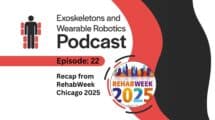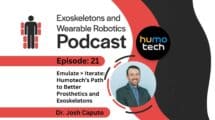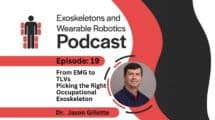Welcome once again to the Exoskeletons and Wearable Robotics podcast. This time, we have as guests the leaders of Bionic Power, one of the first exoskeleton companies. In this episode, we explore their journey, especially their pivot to pediatric robotics and much, much more! You can view the episode on YouTube or the audio-only version on virtually all major audio channels.
Episode 23 with Bionic Power: Chapter Markers 00:00 – Welcome & Introductions Bobby Marinov and Dr. Tom Sugar introduce the episode and guests: Gualtiero, CEO, and Rob Nathan, Director of Operations at Bionic Power. 01:20 – From Military to Medical How Bionic Power began in 2007 developing energy-harvesting knee exoskeletons for soldiers, and later pivoted to medical rehabilitation for children with cerebral palsy. 04:40 – Understanding Crouch Gait Rob Nathan explains crouch gait and how the company’s device helps children fully extend their knees and walk with less fatigue. 07:00 – Light, Smart, and Personalized Design: Why low-torque, lightweight actuation combined with custom orthotic integration is key to making the device safe, comfortable, and long-lasting. 12:30 – Life-Changing Results: Catalina’s Story Real-world success story: a young girl who moved from a wheelchair to walking and dancing thanks to Bionic Power’s Agilik system. 16:30 – Intelligent Control & Safety Discussion on software-controlled torque and position, preventing hyperextension, and supporting both unilateral and bilateral users. 19:00 – Regenerative & Stair-Climbing Capabilities New modes allow walking down ramps and stairs, even recharging the battery while descending. 22:00 – Commercialization & Insurance Coverage: How patients access the device through certified orthotists, and details on U.S. insurance reimbursement and distribution partnerships. 29:45 – Impact on Pediatric Mobility: Why early mobility intervention matters: improved endurance, gait mechanics, and potential lifelong benefits for children. 35:00 – Durability & Closing Thoughts Tested for millions of walking cycles, the system shows military-grade durability. The episode closes with optimism about future clinical studies.
Learn more: Bionic Power: https://bionic-power.com
The podcast is also available on all major streaming platforms: Apple Podcasts, Spotify, Amazon Music, Podcast Index, Overcast, iHeartRadio, Podcast Addict, Castro, Castbox, Podchaser, Pocket Casts, Deezer, Listen Notes, Player FM, Goodpods, TrueFans, or you can even listen to it directly from the embedded player below!
Summary of the Episode (AI Generated):
This episode of the Exoskeletons and Wearable Robotics podcast features Bionic Power’s CEO Gualtiero and Director of Operations / industrial designer Rob Nathan. The conversation traces Bionic Power’s journey from a military energy-harvesting knee exoskeleton to a pediatric and adult medical device for gait assistance, with a strong focus on children with crouch gait due to cerebral palsy, spina bifida, and related conditions.
Gualtiero explains that Bionic Power was founded in 2007 to solve a very specific defense problem: reducing the number of batteries soldiers had to carry. Their original exoskeleton used passive knee motion to generate electricity while walking, especially when going downhill with heavy loads. The hardware met U.S. Department of Defense requirements and worked well in field tests, but as lithium batteries improved and got lighter, the benefit of saving only a few hundred grams in a backpack wasn’t compelling enough for soldiers to adopt another wearable device.
The company’s real turning point came when they connected with researchers at the U.S. National Institutes of Health (NIH). NIH teams were using bulky lab-built devices to help children with cerebral palsy and similar conditions, and Bionic Power realized their compact, field-tested knee exoskeleton could be repurposed as a medical device. Military investment had effectively subsidized a high-quality actuator that could now be used to serve a pediatric population that normally attracts far less R&D funding. Gualtiero describes this as a rare but beautiful example of defense spending translating into a civilian medical benefit, and something he’s genuinely proud to lead.
Rob then shifts the discussion to the current medical product, called Agility. The primary initial target is crouch gait, where children walk with chronically bent knees due to weakness, contractures, or neuromuscular issues. This posture makes walking biomechanically inefficient, like moving through life in a perpetual squat, so as they grow and gain body mass, many kids become progressively more fatigued and eventually end up using wheelchairs part- or full-time. The device provides torque at the knee to help them reach more normal extension during stance (and flexion in swing if needed), while always staying under the wearer’s motor control rather than imposing a pre-programmed gait.
One of the big technical insights in the episode is that these patients usually don’t need huge amounts of torque. Coming from augmentation and industrial exoskeleton thinking, the team originally assumed they would need 30–40 Nm at the knee. In practice, for many crouch-gait kids and post-stroke adults who can already walk but need stability or a bit of help, around 12 Nm—or even less—combined with the person’s own muscle capacity is enough to make a dramatic difference. That lower torque requirement enables a very light system: a small battery pack in a fanny pack lasting more than a day, and actuators under 0.5 kg per leg, mounted on a custom KAFO (knee-ankle-foot orthosis).
The device is integrated into a custom orthotic shell molded to the user’s leg. This tight, individualized interface allows low torque to be used efficiently and comfortably. Control is torque-based rather than position-based: onboard sensors detect gait phase, and a clinician can tune how much assistive or resistive torque is applied in each phase, including fine control over the last few degrees near full extension to avoid hyperextension. The system can also be flipped into a “reverse” mode so the user must work against the actuator, turning it into a therapeutic exercise tool. The device supports unilateral and bilateral configurations, with each leg controlled independently, particularly important for post-stroke patients who often have one affected side.
A major chunk of the conversation is devoted to real-world stories. One frequently discussed example is Catalina, a young girl with crouch gait who previously used a wheelchair to get to school simply because walking was too energy-expensive. With the device, she is able to walk through the whole school day, play, and even dance on stage. Before, she could only manage two houses while trick-or-treating; with the exoskeleton, she went door-to-door for two hours and was the last family member to want to go home. Remarkably, she achieved this with only about 4 Nm of torque at the knee, underscoring how small biomechanical changes can translate into enormous quality-of-life improvements.
The hosts and guests also explore the social, behavioral, and long-term clinical dimensions. Not all children use the device equally: younger kids (roughly 6–12) tend to wear it happily all day, while teenagers, despite potentially huge benefits, may resist wearing something visibly different at school. The team has evidence from published papers that the device improves gait biomechanics (extension angle, stride length, walking speed) and endurance, but proving that it delays or prevents long-term wheelchair dependence would require massive, decades-long studies. For now, they combine quantitative data, like step counts in the millions over several months, with the widely accepted clinical principle that “more walking is better” for musculoskeletal health.
On the commercialization side, the device is a class-one microprocessor-controlled stance and swing knee joint that can be prescribed by physicians and integrated by certified orthotists. In the U.S., it is reimbursed under a specific HCPCS code with per-leg reimbursement on the order of $37–38k, covered broadly by Medicare for adults and variably by Medicaid at the state level for children, plus some private insurers. Bionic Power is rolling out the product via major orthotics networks such as Hanger Clinic in the U.S. and Thuasne (a French company with a strong U.S. presence), both of which also invested in the company’s Series A funding round. This combination of a reimbursement pathway and established distribution channels is highlighted as a key differentiator relative to many wearable robotics startups that never fully solve the “who pays and who delivers?” problem.
Near the end, the conversation touches on research and the current wave of “AI-branded” exoskeletons. The Bionic Power team avoids calling their system “AI” and instead emphasizes robust, tunable control grounded in clinical use. They talk about plans to offer a research-oriented actuator version so labs can experiment with custom control algorithms on a commercial-grade, medically rated hardware platform, potentially accelerating innovation while avoiding redundant work on motors, gearboxes and safety certification. Finally, they note that clinicians and orthotists are being invited to try the device themselves at demos and workshops; once they feel the effect on their own legs, many reconsider traditional assumptions like the need for rigid AFOs in certain conditions, which in turn sparks new clinical questions and ongoing studies.
Special thanks to all of our Patreon supporters!
We wouldn’t ask for your help if we didn’t need it. Truth be told, the Exoskeleton Report is far from breaking even (if one counts all the time I and others spend on it). If you enjoy this podcast or our recently restarted series of TikTok videos, please support our efforts to popularize and demystify exoskeleton technology now!











Add Comment